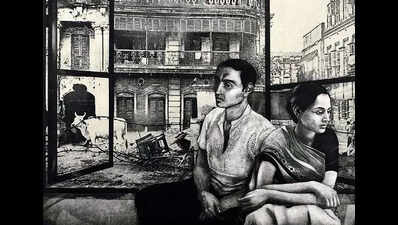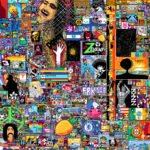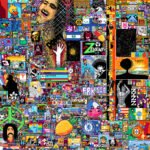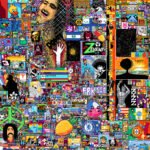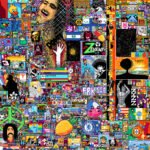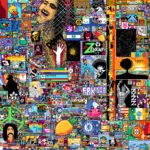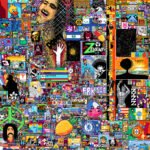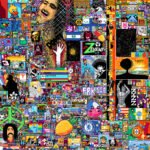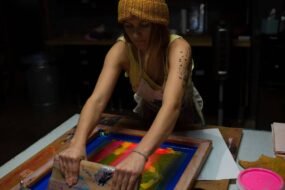
After finishing their medical tests in Fort last Tuesday, Nagpur’s Srinath Meisanwad and Nashik’s Neeta Deshmukh found themselves with a few hours to kill in the city where they’d soon begin work. Skipping a planned visit to the Gateway of India, theypaid Rs 20 each to step into a building that offered a gateway into India. “Looking at these artworks feels so peaceful…” said Meisanwad, pausing before a wooden artwork at the NGMA which showed a girl resting amid trees, birds and butterflies. “So much better than looking at reels,” he added, staring at the woodcut by Arti Kashyap titled ‘Nature Can Repair Everything’.
In its second edition, ‘Nabha Sparsh: Indian Women Printmakers‘—a sprawling, multi-generational showcase featuring 150 women artists—is drawing in wanderers and art lovers. On view until May 15, the month-long exhibition took root as an idea on Women’s Day last year when Sanjeev Kishor Goutam, NGMA Delhi’s director general, invited the noted artist Anupam Sud to be felicitated on the occasion. “That’s when it struck me. Why not celebrate the entire legacy of women printmakers?” says Goutam, a printmaker himself.
A centuries-old process that transfers images from block, metal plate or screen to paper or fabric, printmaking has evolved to include a range of techniques. From intaglio, where ink is forced into grooves or cavities in the surface of the ‘matrix’ to stencil, where ink or paint is pressed through a prepared screen or material with cutout elements, a variety of printmaking methods are on display.
“Historically, printmaking was perceived as a labour-intensive practice. There was a belief that it was better suited to men,” says Goutam, adding that during the East India Company’s reign, printmakers were “explicitly recruited from among men”. “But in truth, what printmaking really requires is patience and precision—qualities not limited by gender,” he added.
Few women ventured into the field and even fewer gained recognition. In the late 1960s, when renowned printmaker Jagmohan Chopra founded ‘Group 8’—a collective that promoted awareness about printmaking at a time when metal was scarce—it featured seven male practitioners and only one woman: Anupam Sud. Decades before the advent of terms like ‘me-time’, Sud portrayed women burdened by repetitive social roles—mother, daughter, wife—longing to be their truest selves. Stripped of adornment—no clothes, colour, jewellery or even hair—her figures captured the timeless conflict of the time-starved everywoman. “It was only after pioneers like Sud and Zarina Hashmi emerged that women printmakers gained visibility,” says Goutam.
Curated by NGMA’s Shruti Das, ‘Nabha Sparsh’ (‘To touch the sky’) draws from the gallery’s collection to highlight the works of icons such as Rini Dhumal, Lalitha Lajmi, Naina Dalal, Jaya Appasamy, Kanchan Chander, Pratibha Dakoji, Shobha Ghare and Anita Das Chakraborty among others.
The late Gogi Saroj Pal, known for her myth-infused etchings—‘Nayika’, ‘Kamadhenu’, ‘Kinnari’, ‘Hath Yogini’—which explored femininity through hybrid forms, stands out as the nayika (heroine) of the showcase. Thirty two photos on the top floor capture Pal in various moods while a display of personal letters written in Hindi to her son, Marish aka Punnu, offers a rare glimpse into her life as a mother. One undated letter drips with timeless relevance: ‘Love… I am designing a poster to be sent to Russia. It is against nuclear weapons for war… I want to see you as a grown-up man in a world without wars.”
A hidden heroine of the showcase is Mumbai. “There’s a fascinating story of VP Madhav Rao, the Dewan of Travancore, encouraging Varma to send his paintings to Europe for printing,” says Nidhi Choudhari, director of NGMA Mumbai. “Later, Varma set up his own press in Girgaum in Mumbai and it was his prints of gods and goddesses that made him a household name and democratised the divine,” says Choudhari, adding that this “vital chapter of art history remains unknown to most.”
Also featuring works by Goutam’s students including Priya Mishra, Priyanshu Chaurasia and Janvi Kemka, “a remarkable young artist who is deaf and mute and currently working in London”, the show aims to promote young talent for whom the spotlight remains elusive. “Many young women from places like UP, Bhopal and beyond are entering the fie,” says Goutam. “Unfortunately, the art world tends to focus on established names, making it harder for new voices to be heard.”

